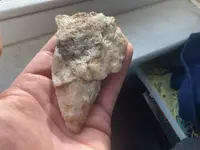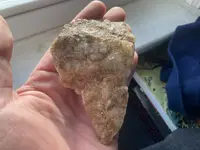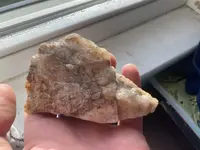You are using an out of date browser. It may not display this or other websites correctly.
You should upgrade or use an alternative browser.
You should upgrade or use an alternative browser.
Vague tool forms
- Thread starter Fred250
- Start date
Fred250
Hero Member
- Joined
- Jun 30, 2018
- Messages
- 541
- Reaction score
- 465
- Golden Thread
- 0
- Primary Interest:
- All Treasure Hunting
- #61
Thread Owner
Thank you Mr Uniface for taking the time to share knowledge with us and put my mind at ease even though I knew I was right because it’s “ no brainer” obvious in person. I think that’s all I needed out of this, it’s been a fun couple years here but I going to retire from posting. I’m sure I’ll still read but I spend too much time on here. I was once told by a knowledgeable member I liack the experience to identify worked stone from natural but that was a load of crap, it’s not that hard. The rock art is real as well, whether you like it or not. How it relates to these crude but “ingenious” tools I don’t know but I think you all know my opinion on who was making them.
Thanks for putting up with my BS and not banning me for disagreeing with the majority opinion.
Thanks for putting up with my BS and not banning me for disagreeing with the majority opinion.
uniface
Silver Member
- Joined
- Jun 4, 2009
- Messages
- 3,216
- Reaction score
- 2,905
- Golden Thread
- 0
- Location
- Central Pennsylvania
- Primary Interest:
- Other
No call for disconnecting, Fred. If you let yourself depend on what others think, you're in for a rough ride.
First off, probably the best single resource for anyone genuinely interested in early lithic technology is
www.donsmaps.com
There's enough neat stuff in there to last you several months, all identified.
Second, your tools are boxed up & ready to call fedex tomorrow, Fred. Today's too busy.
Fibnally, if you really are interested but lack the motivation to put the time in, the executive summary is: look for useable edges -- low angle ones for cutting, +/- 90 degree ones for scraping/planing/burin engraving and acute points for piercing. When your whole assemblage shows one or several of these features, with a few turtleshell flake cores thrown in, it's pretty obvious.
especially when the material would maybe be best described as "rotten quartz" -- not uniform in consistency the way vein quartz is, but quartz bits cemented together by more quartz. The likelihood of this naturally fragmenting into +/- 30-degree and 90-degree angles, many with acute points (a few at both ends) is pretty remote.
For good measure, under magnification, a few do evidence deliberate edge retouching when the material is coherent enough to show this. Not the high-angle edge damage you'd expect to see from ground churning/frost heaving when tightly packed together (the way points do from rattling around loose in a cigar box), but @ angles as low as the edges.
I should probably have just let this go, but it's a slow news day, and some traffic beats no traffic.
PS : Do check out donsmaps if you like paleolithic tools. It's a treat.
First off, probably the best single resource for anyone genuinely interested in early lithic technology is
www.donsmaps.com
There's enough neat stuff in there to last you several months, all identified.
Second, your tools are boxed up & ready to call fedex tomorrow, Fred. Today's too busy.
Fibnally, if you really are interested but lack the motivation to put the time in, the executive summary is: look for useable edges -- low angle ones for cutting, +/- 90 degree ones for scraping/planing/burin engraving and acute points for piercing. When your whole assemblage shows one or several of these features, with a few turtleshell flake cores thrown in, it's pretty obvious.
especially when the material would maybe be best described as "rotten quartz" -- not uniform in consistency the way vein quartz is, but quartz bits cemented together by more quartz. The likelihood of this naturally fragmenting into +/- 30-degree and 90-degree angles, many with acute points (a few at both ends) is pretty remote.
For good measure, under magnification, a few do evidence deliberate edge retouching when the material is coherent enough to show this. Not the high-angle edge damage you'd expect to see from ground churning/frost heaving when tightly packed together (the way points do from rattling around loose in a cigar box), but @ angles as low as the edges.
I should probably have just let this go, but it's a slow news day, and some traffic beats no traffic.
PS : Do check out donsmaps if you like paleolithic tools. It's a treat.
fishstick
Silver Member
Hey there Fred, I know you said you were finished posting but I have to ask. Have you found any points or blades at this site and if so could you post a few?
Similar threads
- Replies
- 2
- Views
- 442
- Replies
- 25
- Views
- 1K
Users who are viewing this thread
Total: 1 (members: 0, guests: 1)




